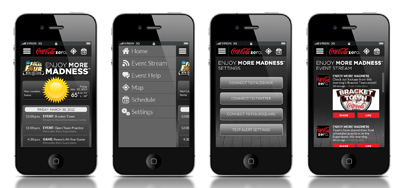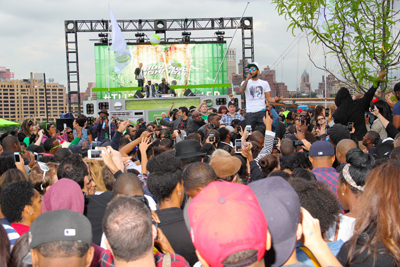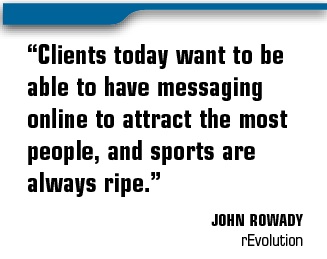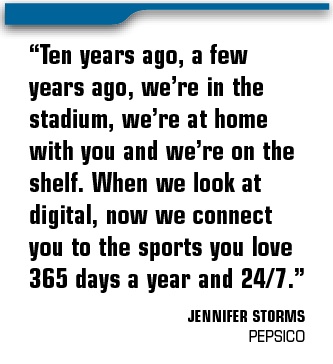Remember when lining up “likes” on Facebook was a coup? Now sports sponsors, and the agencies that help bring those alliances with leagues and teams to life, want much more. They consider Twitter and Facebook mandatory for just about any marketing campaign, and they realize success means more than just putting a couple of logos next to each other in a message.
Talk to brands and agencies alike and it becomes impossible to avoid words such as “unique content,” “authenticity” and “passion.” All of which is industry-speak for giving people — in this case, sports fans — something they might actually read or click on and pass along to their online followers and friends.
“It has to resonate with customers,” said Brian Gainor, director of strategy and analytics at Freshwire, a new digital content company owned by Omnicom Group. “Fans demand more access and personalization.”
The right mix of social media offers handsome rewards, starting with the ease of getting near-instant responses from the audience on what works and what doesn’t. And when a campaign or promotion goes viral, the transformation can turn advertising and marketing into much more credible word-of-mouth. Or, in this case, word-of-mouse.
 |
Coke Zero’s mobile concierge for the NCAA Final Four.
Photo by: CSE |
Making such connections with consumers has become a point of emphasis for brands. Using the power of sports in digital and social media provides a much more direct link to the audience.
Contests, prizes, games, videos and behind-the-scenes vignettes tend to hold the attention of fans, marketing experts have found. And this kind of marketing increasingly starts with iPhones and Androids and from there migrates to laptops, desktops and televisions.
The Marketing Arm, creators of a seasonlong college football campaign dubbed “On the Way to Saturday” (see story, Page 30), has tracked usage and found mobile traffic surging ahead of desktop traffic by a 4-to-1 ratio.
“Nothing’s more personal to you than your phone,” said Adam Zimmerman, president of marketing at Atlanta-based sports marketer CSE. “It’s with you at all times. If the goal of a sponsorship is to put you into an environment created by the sponsor, I can do that on your phone.”
CSE, for example, worked on behalf of Coke Zero to launch a mobile concierge this year for the NCAA Final Four in New Orleans. The mobile website included standard information on game and practice times, special events and concerts tied to the championship.
Beyond those elements, the mobile website featured maps and alerts, social media connections to see what other basketball fans were up to, and Coke-themed offers. For example, a screen shot of the New Orleans page featured a capsule detailing the history of local institution Acme Oyster House with directions to the restaurant and a targeted
coupon for $2 off oysters with the purchase of, yes, a Coke.
Companies, steered by marketing firms, often target the so-called influencers in social media, fans or consumers who have large followings on Facebook, Twitter and other social networks — and who tend to set the agenda when it comes to chatter about a particular team, school or sport.
Special offers resonate, as do contests and access to content online or elsewhere that wouldn’t otherwise be made available. Nationwide Insurance, title sponsor of the feeder series to NASCAR’s top division, worked with Turner Sports to provide fans with live coverage online that includes 10 alternate camera angles, audio from the scanners used by drivers and crew chiefs, and a constantly updated leaderboard.
The online features, known as RaceBuddy, were just part of the digital push by the insurance company in racing. Slice-of-life videos, along with outtakes from the shoots, profiled several drivers. Earlier in the season, a four-part series following driver Danica Patrick aired on Nationwide.NASCAR.com. In each case, Facebook pages and Twitter accounts tied to the race teams, the series and the sponsor promoted the content, funneling fans to the website and creating conversation topics.
“It goes back to the second screen,” said Mary Spencer, vice president at Wasserman Media Group, Nationwide’s agency. “You get more content and data.”
Status update
Agencies are perfecting the art of luring customers and guests to tweet and post links about events and promotions that tie sponsors to sports and entertainment.
Engine Shop, a New York firm prepping an undisclosed Super Bowl-related project, illustrates the increasing attention to detail when planning an event. Last summer, the agency helped Bud Light Lime with a 10-city tour of happy hour invitation-only events, culminating with a New York party at a 2,500-person capacity venue.
 |
Bud Light Lime staged a 10-city tour of happy hour events that used social media to dole out invitations and spread the word about the event.
Photo by: Engine Shop |
To accept an invitation, the handpicked influencers, as researched by the agency, had to either tweet or post on Facebook. Those messages, in turn, prompted more response by telling each invitee’s network of followers and friends that they, too, might be invited, but could find out only through more clicking and social media steps designed to promote the beer and the tour.
Those who went to the private parties found it all but impossible not to mention the beer as they dashed off messages on their phones.
Josh Pelz, Engine Shop’s head of digital, notes the New York finale included an enhanced Wi-Fi network to ensure easy communication. Guests received a laminate upon arrival that told them how to access the Wi-Fi network, what the hashtag was, the Twitter handles of celebrities at the event in case they were mentioned in messages, and a link to the Foursquare check-in. To encourage chatter and content such as photos and videos, a large wall behind the stage collected and projected all of the mentions of the event, prompting people who wanted to see their comments and posts displayed. The effort generated 19 million Twitter impressions for the New York event alone, Pelz said, and demonstrated the direction such campaigns are heading toward.
Companies love the way social media can enhance a tour or one-off event, delivering more value on an investment that would otherwise have a limited shelf life. Twitter and Facebook and other online conversation and sharing creates a three-part arc: anticipation before the event, accounts of what happens during it, and then recaps and remarks in the days after on what transpired.
“Clients today want to be able to have messaging online to attract the most people, and sports are always ripe,” said John Rowady, founder and president of rEvolution, a sports marketing and media agency. With that in mind, companies must answer the question of what to do with social media in the context of a campaign. Or, as Rowady puts it, “How can I layer in components that differentiate you from other brands?”
His clients include ESPN, which works with rEvolution on its NBA-themed RV tour. The agency uses television spots created by Wieden & Kennedy as the anchor for a Facebook fan page and Twitter feed tracking the tour (whichever NBA games ESPN covers on Wednesdays, Fridays and Sundays). The agency has a few staffers riding along on the tour, responsible for creating and linking reports on the broadcasters’ meeting fans in different cities, adventures on the road, and backstage clips of commercial shoots and other snippets.
Rowady cautions against judging social media the same way as TV audiences; that is, by mass appeal. Instead, he said, thinking “big numbers are great and small numbers are terrible” misses the point. If the right audience sees and likes a social media campaign, the value can be just as effective because the conversation is one-to-one.
One of the most popular digital tools for on-site events is so-called RFID technology, or radio-frequency identification.
Tiny computer chips embedded in bracelets or lanyards can transmit useful information, from guest preferences (allowing, for example, product or team features on a screen or kiosk to be tailored to the person standing before the display) to tracking how many stops a person made in an interactive area and where they spent the most time.
Bryan Rasch, senior vice president of digital strategy at GMR Marketing, said a campaign on behalf of Canadian telecommunications company Telus at last year’s Canadian Football League championship did just that. While the company learned what people liked best, the RFID technology also made things easier for fans because it sped up access to specific areas and loaded information on preferences using the chip.
Whether it’s RFID or Twitter, Rasch said companies, and the teams and properties they align with, want the same thing: to become integral links and focal points during times when consumers are having fun. “Teams and brands love it because they are part of the conversation,” he said.
PepsiCo, among others, proves the point. From conversations between star athlete endorsers and weekend warriors on the benefits of Gatorade in competition, to fan-generated montages marrying NFL fandom with Pepsi-owned soft drinks and snacks, the company takes varying approaches to social and digital campaigns.
No matter the tone, they all share one characteristic, company executives say. They marry sports, PepsiCo and fans in a new, constant way.
“Ten years ago, a few years ago, we’re in the stadium, we’re at home with you and we’re on the shelf,” said Jennifer Storms, PepsiCo senior vice president of global sports marketing. “When we look at digital, now we connect you to the sports you love 365 days a year and 24/7.”
Just don’t forget the hashtag.
Erik Spanberg writes for the Charlotte Business Journal, an affiliated publication.







